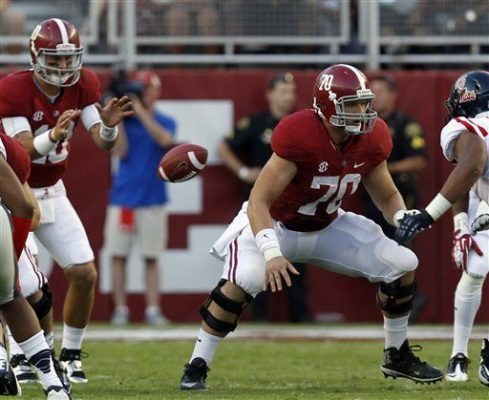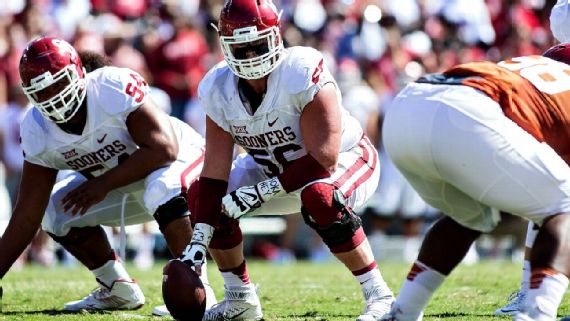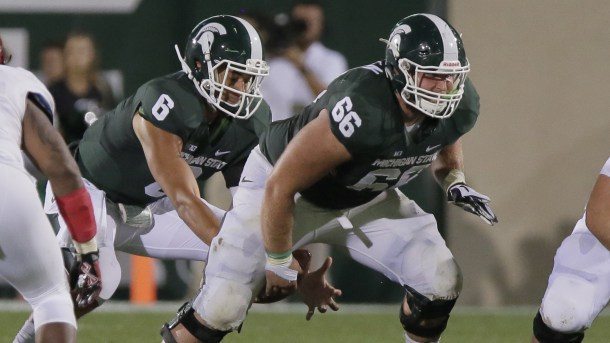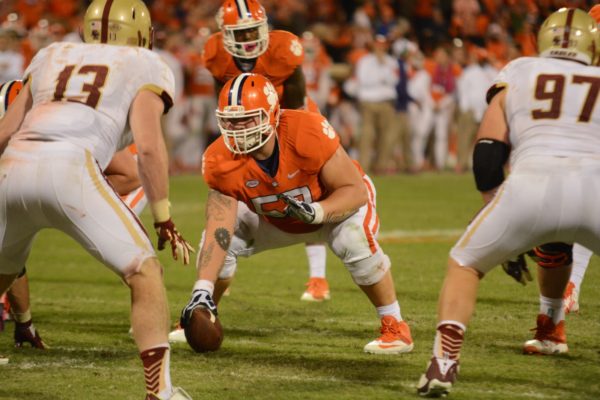Meet the Smartest Guys On The Football Field

In the College Football Playoff Semifinal at the Capital One Orange Bowl Thursday Dec. 31, the Clemson Tigers defeated Oklahoma 37-17 while in the CFP Goodyear Cotton Bowl, Alabama overwhelmed Michigan State 38-0. But the four centers had a key role for each of their teams. That’s why they were acknowledged prior to the game in this ESPN article written by Adam Rittenberg as pretty intelligent players.
Want to get smart about the playoff? Start by learning about the smartest players on each of the four teams.
The names Ryan Kelly (Alabama), Ty Darlington (Oklahoma), Jack Allen (Michigan State) and Jay Guillermo (Clemson) might or might not ring a bell. Few fans, not counting ex-offensive linemen or O-line junkies, could identify all four. But those seeking SGITR (smartest guy/gal in the room) status at Thursday’s playoff watch parties should know who they are.
So where does this cram session begin? The same place each play from scrimmage does: under center.
“What an odd way to start a play, putting a ball between your legs,” Michigan State offensive line coach Mark Staten said. “You’ve got to be precise with that and also be precise with the directions you’ve given everybody else as that play’s about to happen. And a split second before that play happens, [the opponent has] shifted or moved, and you’ve got to trust your line mates to adjust accordingly.
“It’s a strange position.”
Link to original story.
It’s also a fascinating, multilayered position played by bright, charismatic, selfless individuals. Other than quarterback, center is considered the offense’s most important component, what Kelly calls “the governor of the offense,” even though centers receive a fraction of the attention.
They’re big men with little egos and broad shoulders, capable of carrying a heavy burden on every play and in every game.
Said Allen, a four-year starter,
“It’s a lot more than just snapping the ball and running into another fat guy.”
Lesson 1: Centers are really, really smart
The Campbell Trophy, formerly the Draddy Trophy, is best known by its nickname, the Academic Heisman. It’s the most prestigious academic award in college football.
When Darlington went to New York for the Campbell Trophy award ceremony earlier this month, he wasn’t surprised that two of the other 12 finalists, Ohio State’s Jacoby Boren and UCLA’s Jake Brendel, also played center. No other position produced more than two finalists. Kelly and Allen, a four-time Academic All-Big Ten selection, both were semifinalists for this year’s award.
“That’s not a coincidence,” said Darlington, who became the second center in the past four years to win the Campbell Trophy. “The center has to be the brain. He has to be the smartest guy up front, if not the smartest guy on the field, to be able to adapt and make decisions under fire.”

Alabama offensive linesman Ryan Kelly (70) blocks out after snapping the ball to quarterback A.J. McCarron (10) during the first half of an NCAA college football game against Mississippi on Saturday, Sept. 28, 2013, in Tuscaloosa, Ala. (AP Photo/Butch Dill)
A center’s responsibility on a given play includes but is not limited to setting the protection and potentially sliding it in one direction, depending on the defensive look; identifying the “point linebacker,” who triggers assignments for other offensive linemen; surveying safety depth and how it relates to the type of front being shown (even, odd, bear, and so on); and knowing the quarterback’s cadence and snap count. They also have to snap the ball seamlessly and, if the quarterback is in shotgun, accurately.
Centers have to enjoy deconstructing the game, learning what everyone is doing and why plays succeed or fail. They have to watch film until their eyes gloss over but also make instant decisions in games when the defense provides new looks.
“I don’t know if we’re all Einsteins, but we accept the responsibility that comes with the territory,” said Kelly, who won the Rimington Trophy as the nation’s top center this season (Allen was a finalist). “You have to be almost perfect all the time, but you’re going to mess up more things that you get right at first.
“A lot of things that make centers successful are trial and error.”
Successful centers embrace the mental challenges. When Darlington first came to Oklahoma, he forecasted a post-football career in the medical field. His outlook changed when offensive line coach Bill Bedenbaugh arrived three years ago.
Bedenbaugh pushed the linemen to dissect opponents’ tendencies: a pass rusher’s favorite moves, the way safeties trigger blitzes with their coverage assignments. Football was complex, and Darlington fell in love with it. Coaching is now a possibility for him when he’s through.
“I started thinking, ‘Playing football at this level, especially those who are great at it, aren’t inferior to anyone in intelligence,'” said Darlington, who earned his bachelor’s degree at Oklahoma in two and a half years while maintaining a 3.91 GPA and is now pursuing a master’s. “I can break it down, how it works, the system. If you tell me a formation, I could tell you the top two fronts Clemson is going to line up in.”
When Michigan State’s offense ends a possession, Staten peppers Allen with questions and gets the answers he needs from him.
“What look did we get? Did they do something different? With the safeties in, did that change the protectional point?” Staten said. “His overall knowledge and genuine football IQ is terrific. It helps in everything we’re doing.”
Centers have to be multitaskers, according to Dave Rimington, perhaps the greatest to play the position at the college level. Rimington, a two-time Outland Trophy winner at Nebraska and the only lineman to ever win Big Eight Offensive Player of the Year honors (1981), has seen smart linemen who froze up when put at center.
“You can’t go up and down,” Rimington said. “You facilitate greatness. You have to facilitate everyone else who are the playmakers and you can’t make the mistake.
“You know you’ve got an important job, but nobody else really does on the outside.”

Oklahoma’s Ty Darlington offers a pretty simple job description of centers: “The center has to be the brain. He has to be the smartest guy up front, if not the smartest guy on the field, to be able to adapt and make decisions under fire.” Icon Sportswire/AP Images
Lesson 2: Snapping isn’t easy
About all the outside sees of the center is the snap. The expectation is perfection. Any problems can be disastrous.
Just ask Stanford, which had two fumbled snaps in a 38-36 loss to Oregon that essentially eliminated the Cardinal from playoff contention.
Alabama coach Nick Saban said of centers:
“The guy’s got to be physical, he’s got to be quick, he’s got to be able to handle nose guards, he’s got to be athletic enough to block at the second level, and he’s got to be able to handle the ball. That’s what a lot of guys can’t do, handle the ball.”
The snap itself, like the center position, is a football oddity. While the other four linemen position themselves for power or agility or leverage, the center is, by rule, off balance.
He is not only closest to an opposing defensive lineman but, if the offense operates from under center, the most direct route to the quarterback. Snap-stepping, a skill confined to the center, is football’s version of rub-your-stomach-pat-your-head. Your arm moves backward, but your feet move forward.
“The mechanics are different than any other position,” Darlington said. “It’s the snap and being able to get that hand back up for blocking. You’ve got a 320-pound dude about eight inches from your face, and you can’t grab him with your right hand until you snap the ball between your legs and get that hand back up.”
Snapping is not natural for many. In high school, Allen, a player “who has to do things 1,000 times,” used to practice snapping by setting up a small clothesbasket atop a garbage can in his driveway. He snapped until he consistently hit the basket without looking.
A strong center-quarterback connection is vital to consistent snapping. When Guillermo took over the starting job from the injured Ryan Norton early this fall, he initially struggled to master Deshaun Watson’s cadence. They worked to get it down.
“You have to be in sync,” Guillermo said.
There’s also the, uh, cozy nature of non-shotgun snaps. Centers and quarterback really have little choice but to get comfortable.
“I tell Deshaun just about every day that I love him,” Guillermo said, laughing. “I’m sure that doesn’t make it any less awkward.”
Lesson 3: Center isn’t for everyone
There are longer and more athletic linemen who play tackle. There are more powerful linemen who play guard. Centers often lack a superlative trait. It’s the sum of their skills that stands out.
“Not everybody can play center,” Kelly said.
All four playoff centers played the position at a relatively young age, including Guillermo, who started in the second grade, but centers are usually transplants from other spots. Bedenbaugh has recruited “very, very few” high school centers. Most who eventually wind up there come in as offensive tackles, tight ends or defensive linemen.
Even then, it’s a gamble.
“Throughout my career, we’ve tried to make guys centers who would have been really darn good centers, but they couldn’t put it all together,” Bedenbaugh said.
Being vocal is non-negotiable. Centers have to be assertive and confident in their calls. Even if they make the wrong call, a play has a chance if the other linemen are aligned.
“You can’t let other people second-guess what you’re doing,” Darlington said.
Centers must thrive on pressure without seeking praise, but they’re not robots. Many of the big men have bigger personalities, such as Guillermo, a locker-room jokester who spares no one, player or coach.
Imitations are his specialty.
“He’s got Coach [Dabo] Swinney down,” Clemson co-offensive coordinator Jeff Scott said. “He’ll listen all week long to the coaches, and then on Friday nights on the bus, on the way to the movie, that’s usually when he’ll get on the mic.”
Added Guillermo:
“It’s a tradition now. I’ve got guys laughing pretty hard every week.”
Allen puts on a different kind of show. He’ll invite his linemates to his apartment, gather them around his bathtub and then feed mice to his pet python (Allen also co-owns a cat named Bubbles that his roommate, Spartans tight end Paul Lang, found on Craigslist this summer).
“They all watched it,” Staten said. “Then he’d bring in his iPhone like, ‘Look, Coach.'”
On senior day against Penn State, Allen became the rare center to be noticed outside of a botched snap or a penalty. With Michigan State up big in the fourth quarter, Allen lined up in the backfield and rumbled 9 yards for a touchdown, stiff-arming a Lions defender on the way.
As fat-guy touchdowns go, Allen, a former high school fullback, graded well.
“I liked it. It was good, but I’m not a big fan of all the attention,” he said. “People want to get on TV and get recognized, but I don’t think many centers care about that.”
Centers prefer to be in the backdrop. But remember them.
The team that reaches the finish line Jan. 11 will owe a lot to the man where each play begins.
ESPN’s Chris Low contributed to this story.

